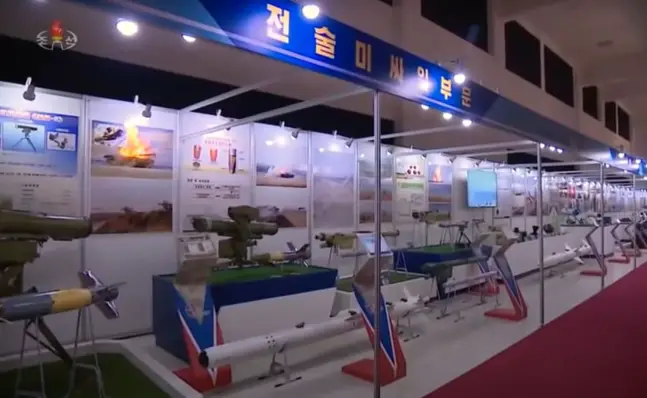By 2025, Poland is prepared to accept 180 Korean K2 Black Panther tanks or three battalions. Along with M1A2 SEPv3 Abrams, Poland hopes to keep the Russians from invading their country. Poland’s K2 version, called K2PL, is set for an armour upgrade as the existing armour is judged too weak for Polish requirements. This update is not scheduled until after 2026, but South Korea has a new reason to upgrade K2’s armour urgently.
According to a recent South Korean Ministry of National Defense assessment, North Korea’s latest anti-tank missile, Bulsae-5 (Firebird 5 or Pheonix 5), can penetrate K2 Black Panther armour.
According to the South Korean military’s internal data obtained on the 27th by Rep. Han Ki-ho, who leads a PPP task force on national security, the armour penetration of the Bulsae-5 was 100-120 cm. It can penetrate the front and sides of the modern K2 and K1 class tanks. The sides and front of the tank have the heaviest armour, and hence most modern and prominent anti-tank missiles are designed to hit a tank from above, where it is weakest.
The Bulsae-5 is a North Korean anti-tank missile with improved performance compared to the existing Bulsae 4. Last October, Bulsae 5 was displayed at the North Korean Defense Development Exhibition’ Self-defense-2021′.
The armoured penetration of the existing Bulsae 4 is 60-80 cm, which was a threat to the front and sides of the K1 series and the sides of the K2. The front of the K2 is thicker than the sides, so the Bulsae 4 cannot penetrate, but the armour-piercing power of the Bulsae 5 is a version that K2 can’t cope with. The estimated range of Bulsae 5 is 5500 m, which is 2500 m more than that of Bulsae 4 (3000 m).
According to the report, the Korean military has learned that Russian tanks struggle against Ukrainian anti-tank missiles ‘Javelin’ and ‘NLAW,’ and the Korean archipelago should prepare for the Bulsae 5.

“The K2 tank is not equipped with an active defense system that can directly destroy North Korean anti-tank missiles,” said Rep. Han Ki-ho. Until then, we need to re-establish a plan to reorganize the (Tank) unit so that it can respond to North Korea’s asymmetric combat and guerrilla tactics,” he said.
Bulsae series Anti Tank Missile
As per reports from the Russian media, the Konkurs anti-tank guided missile, a development of the 9K111 Fagot with greater firepower, was produced under license in the DPRK in cooperation with the Soviet Union. Another version says that ATGM 9K111-1 “Konkurs” were licensed by the North Koreans.
It is uncertain how the ATGM Konkurs may have ended up in the DPRK. Iran, which obtained Kornet-E anti-tank systems from Syria, which received them from Russia, is known to have established its unlicensed manufacturing known as Dehlavieh. It is suspected to be one of the possible sources from where the North Koreans acquired the missile.
Since the source of the acquisition is a mystery, what matters is that at some point, the North Koreans created their improved version of the Fagot. Bulsae-2 is in service with the North Korean army and supplied to the Palestinian Hamas and some other groups.
Bulsae-2 has a similar configuration to Konkurs but likely uses different sights. Fagot had wire guidance. However, it is not known if Bulsae-2 uses the same legacy targeting method or has more advanced laser guidance.
The missile has a high-explosive anti-tank (cumulative) warhead. The range is about 2,000 – 2,500 meters, and armour penetration is about 400 – 500 mm steel armour.
Bulsae-3 is an improved version of Bulsae-2 with a laser guidance system. The launcher has a laser designator that guides the target. The missile has a rear-facing sensor that picks up the beam and causes the missile to fly across it. This missile was publicly revealed in 2016. The missile passed the tests at that time and was ready for mass production. However, there were no official comments regarding the characteristics of this missile. Some sources report that its range can reach 5,500 m. The missile can hit modern tanks with combined armour protection, as per the North Korean media.
The Bulsae-4 missile likely combines an electro-optical guidance head with command guidance via fibre optic cable. However, the antennas of the radio command guidance system used in the Israeli Spike-NLOS are not seen on the launcher of the North Korean system. A DPRK broadcast video uploaded on the Internet on 1 June 2018 showed footage of testing, presumably of this missile, but in the form of a helicopter launch.
Nothing much is known about the Bulsae-5 missile except the information from the South Korean report. The tandem warhead design of the Bulsae-5 allows it to penetrate armour at a range of 4 kilometres, according to other sources. Like some versions of the American FGM-148 missile system, the Bulsae-5 will be capable of a top-down strike.
